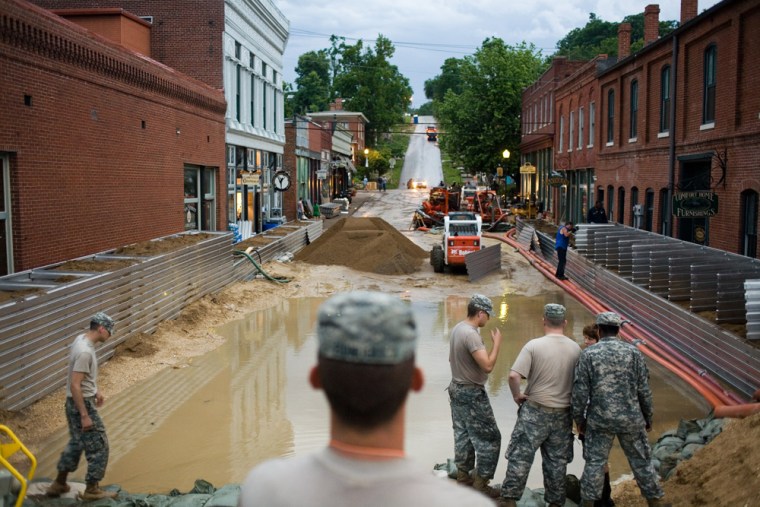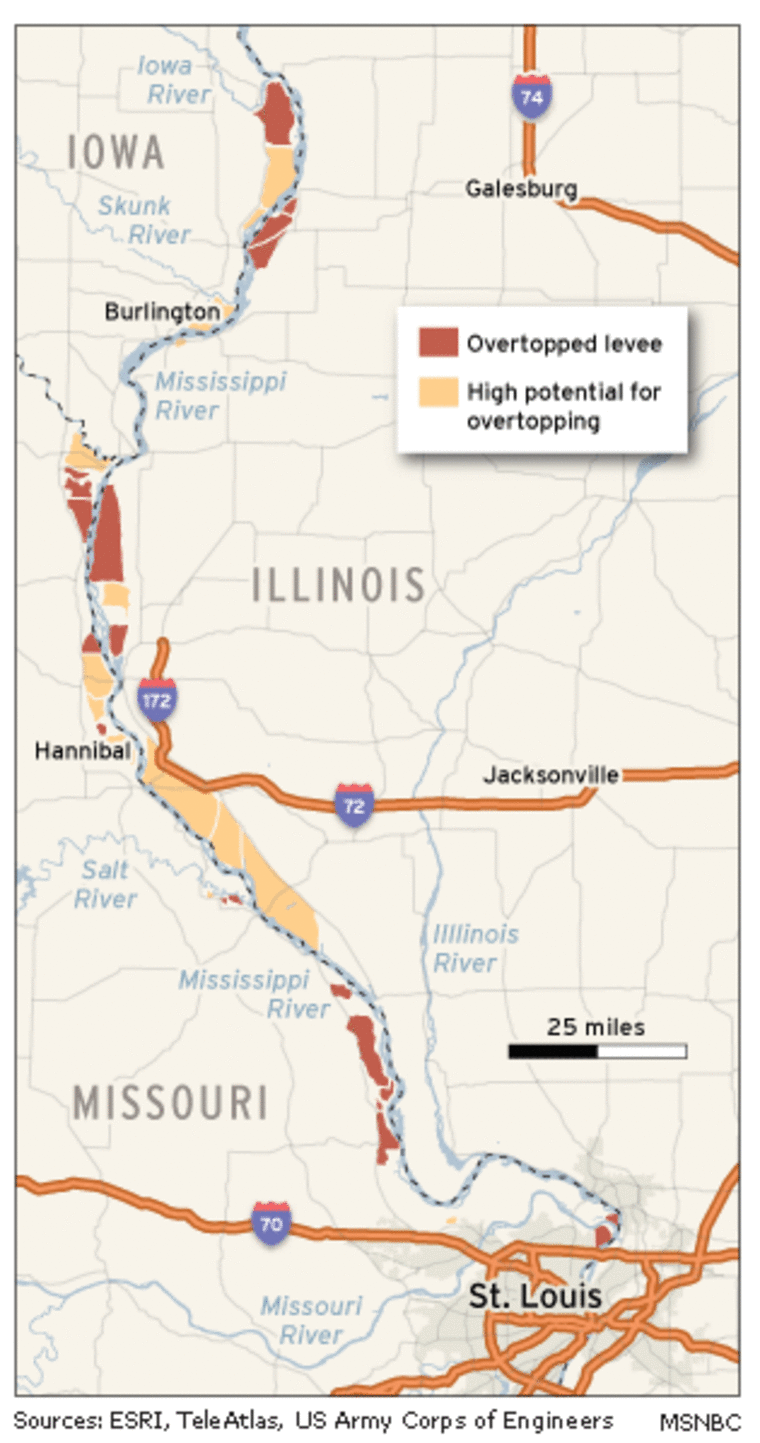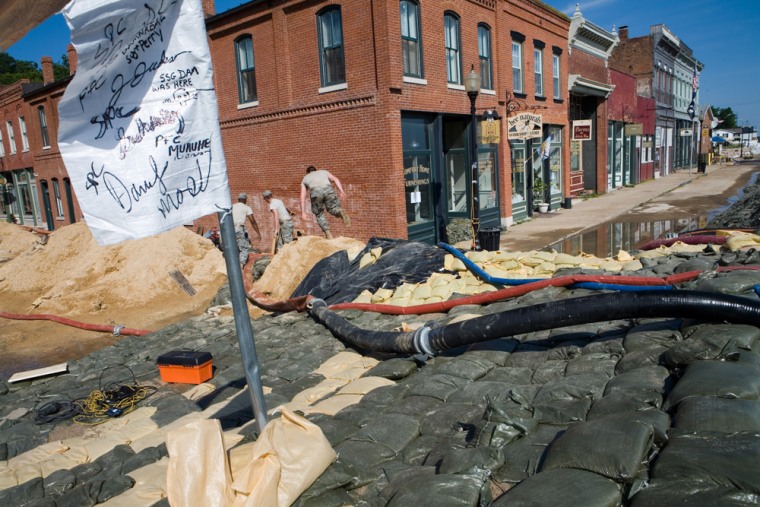Nobody is claiming final victory over the unruly Mississippi here, but they have planted their flags in the sandbags at the flooding river’s edge where, for the moment, they are gaining ground.
Thanks largely to levee breaks upriver and down, the river has been receding for 24 hours and should keep falling until Sunday night. Forecasts now predict a crest Monday at a height well below record levels predicted earlier — and only a few inches higher than it has already reached this week.
Given how well Clarksville’s emergency floodwall has performed, there’s a firm belief among town leaders and residents that the heroic efforts over the last week to fashion an 8-foot-high, three-block-long levee from hundreds of thousands of sandbags will keep the precious art and antique shops from watery ruin.
That’s the latest from Clarksville Mayor Jo Anne Smiley, who gets her information straight from the horse’s mouth — the U.S. Army Corps of Engineers lockmaster at Lock and Dam No. 24 just north of town — before it is posted on National Weather Service Web sites.
At 7 a.m. Friday, the Mississippi had come down from its Thursday high point of 36.27 feet at Clarksville to 35.7 feet, as Smiley learned with a quick phone call to the lockmaster from her inner sanctum at City Hall. The level was predicted to drop to 35.4 feet on Saturday and all the way to 34.9 on Sunday before climbing back to a 36.6-foot crest Monday afternoon.
A decent night's sleep
“If that’s the case, we won’t break the record, and that’s OK,” said a visibly refreshed Smiley, who said she had gotten her first decent night’s sleep in a week. In 1993, the river crested almost a foot higher, at 37.5 feet and previous predictions had it topping out this year over 38 feet.
Elsewhere around town, the mood was also relaxed. National Guard soldiers hunkered down with steaming plates of bacon and eggs and biscuits and gravy, prepared at a nearby school cafeteria and trucked in. And the speechifying was about to begin, with Missouri Gov. Matt Blunt headed to Clarksville for a midday press conference.
“We may have seen the highest,” said Bud Garrison, the owner of a pottery and furniture studio on the riverfront. “The wall’s definitely tall enough.”
A thunderstorm Thursday night and a bit of drizzle Friday were little more than passing annoyances, although the crackle and boom of lightning and thunder over Howard Street sent some workers ducking for cover.
“I’m not going to have anyone get killed saving this town,” said Clarksville Alderman Mike Russell, the town’s emergency services director, urging volunteers to get out of the water while the electrical storm passed by.

Having finished building the main sandbag levee and putting powerful pumps in place to keep the storm drain system from backing up behind the levee, crews on Friday turned to building new sand-filled walls along each side of Howard Street with a product called Metalith, provided free of charge by Infrastructure Defense Technologies. Russell said the idea was to let Howard Street serve as a sort of relief pond for the storm drains, perhaps allowing the pumping to slow, saving diesel fuel and equalizing pressure on the street from below.
‘The backup plan to the backup plan’
“This is the backup plan to the backup plan,” said Russell. The product’s makers “want publicity, and we’re going to give it to them. Anything to save this town.”
The work on Howard Street was evidence that the town had caught its collective breath in the battle to save its downtown core, unprotected by a permanent floodwall so tourists and townsfolk can follow the bidding of Clarksville’s motto to “Touch the Mississippi.”
Russell, 40, was confident enough about the battle that he planned to spend the evening with his wife and three daughters, whom he had barely seen in more than a week. As to when he would consider the emergency truly over, “I’d feel real comfortable if we only had about 2 feet of water against our wall,” as opposed to the 5 to 6 feet lapping at the sandbags.
Even though the forecast of the lower crest is good news, the long period of time that the water is expected to remain high is worrisome, Russell said. “The longer that water is up, the longer those walls have to hold,” he said.
Town not out of the woods yet
Another concern for the wall, said Smiley, is the forecast that the river will quickly rise back from its Sunday level to the Monday crest — nearly two feet in 24 hours. “This will be a danger because that much water all at once will put a lot of pressure on it,” she said.
But Smiley and Russell were already looking ahead to the aftermath of the battle, when they will need to remove tons of sand and assess the damage to the homes and business in town that did flood.
Smiley estimated that about 25 homes in the town of 500 residents got water in their basements and perhaps 15 had flooding to their living areas. The flooding of those buildings, unprotected by the sandbag wall, was a surprise to no one, and residents were able to remove belongings, even stripping out carpet and pad, and pulling doors from their hinges before the water rose.
“I’m proud of this little town and proud of the human spirit that brought all these people here,” Smiley said, referring to the many volunteers who came to assist the townspeople.

Russell said he was unsure exactly how they’ll clean up the sand and where they can dispose of it, as it is likely considered contaminated by chemicals and sewage from the floodwater.
“I’m going to pray that the National Guard stays around for quite some time,” Russell said, referring to the 200 soldiers from the 1138th Transportation Co. and the 1035th Maintenance unit out of Jefferson Barracks, Mo., who have been the constant nucleus of the flood-prevention workforce since Sunday.
Missouri Guard spokesman Gary Stevens said the soldiers would remain in Clarksville “as long as the state tells us they need us here.”
It was the soldiers who raised the first flood battle flag on Thursday, scrawling their names with Sharpies on a white plastic sandbag that they tied to a pole at the high point of the levee. Later, a group of female inmates added their own version to a nearby sawhorse, signing it as “the Pen Princesses of Vandalia.”
The Guard’s banner vanished overnight, but the prisoners’ flag continued to flutter in the gentle breeze coming off the dropping river Friday. In what could be seen as a positive omen, there was no sign of a flock of vultures that had been circling Clarksville for days.
